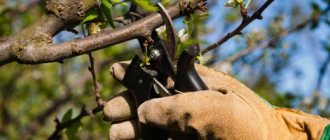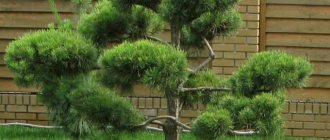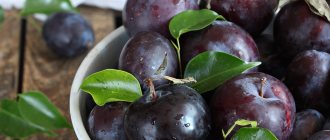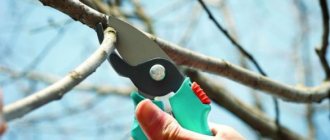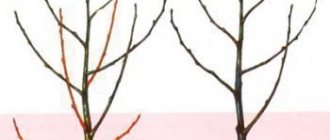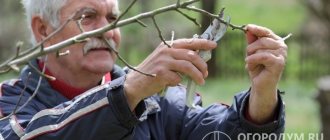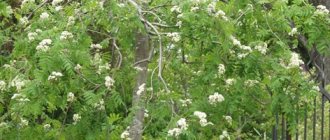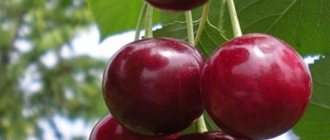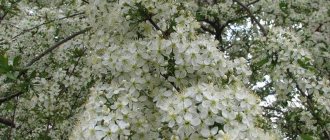The first pruning of the cherry tree should be done immediately after planting the seedling. In the future, this procedure should become a habit for every gardener who dreams of a bountiful harvest.
Cherry is one of those crops whose crown thickens quickly. And the denser it is, the worse the harvest will be and the smaller the fruits. So why not help the plant? Moreover, mastering the science of proper pruning of cherries is not so difficult.
Cherry trees can be pruned in spring or autumn, but more often this is done in the spring, before the buds have yet begun to bloom.
Dates for spring pruning of cherries
In order for the crop to produce a large harvest, it is necessary to prune before the buds wake up.
However, in some cases, pruning can be done after the buds have opened. This procedure is carried out if the tree has been exposed to low temperatures.
Several prunings may be carried out in the spring if the shoots have not recovered from hibernation and require removal; pruning of shoots in the spring is also carried out if the branches are damaged.
Exact timing of pruning
Spring pruning is not tied to a specific date, but is carried out taking into account the regional climate and weather conditions. Even within one region, the timing changes - under the influence of specific weather conditions. The gardener's task is to finish pruning before the sap begins to flow. The activation of the latter is recognized by swollen and opening buds.
In warm areas, pruning is carried out around the end of March, in northern areas - a month later. In the coldest areas, the procedure can be carried out in early May.
If the winter was particularly cold, and there is a high probability that the tree is frozen, pruning is postponed to a later date - in order to assess the extent of the damage from the opening buds and eliminate branches affected by the cold.
The best time for pruning is calm, windless weather. It is advisable that the day be warm - then the risk of gum bleeding (leakage of resin from wounds) is minimized.
Why do you need spring pruning for cherries?
Among the qualities that attract gardeners to cherries is early ripening. This crop grows rapidly and bears fruit. But this advantage turns into a disadvantage - cherries are no less rapidly losing productivity. This quickly aging tree requires regular pruning - if you ignore it, the cherry dies prematurely. Spring pruning goals:
- Crown formation. The plant should be symmetrical. Its crown is given the desired shape and thinned out to avoid thickening.
- Productivity regulation. Proper pruning significantly increases the productivity of cherries.
- Removing old and damaged branches. Together with diseased and dry branches, they remove sources of infection and prevent its spread.
- Improvement of fruit characteristics. By removing excess branches, it is possible to improve the taste of the fruit and increase its size.
- Rejuvenation. A special pruning technique significantly extends the life and fruiting of the plant.
The main mistakes when caring for a tree
It is sometimes difficult for novice agronomists to properly care for a plant, so some first samples suffer from ignorance of the rules of care. What mistakes do gardeners make when caring for trees?
- They prune the tree in summer or winter, treating with pruning shears the branches or shoots that bore the most berries or that can last for a long time.
- Shoots that have grown too much are not shortened in a timely manner.
- They do not monitor frozen branches or those that have already spent their resources. Some novice gardeners think that the thicker the tree, the more fruit it will bear, but this is not always the case.
- They do not follow sanitary rules when processing crops: they work with dirty tools, and so on.
Experts in the field of gardening and vegetable gardening say that cut branches should not be allowed to fall into humus, as diseases and infections develop in them. If you see that the cherry tree can no longer be saved and the infection has spread to the skeleton and main branches, then it should be dug up and replaced with a new seedling.
Preparation and rules for pruning cherries in spring
Before you start pruning, you should prepare all the tools that may be useful. During the pruning process, the following rules must be observed:
- you should determine which branches need to be deleted. First of all, branches that are damaged and those that come into contact with each other in different places are removed;
- if the branches are intertwined, both are removed or one of the branches is shortened;
- for bush crops it is necessary to leave at least 7 branches that make up the skeleton of the plant; annual shoots must be shortened by half;
- all shoots on the tree that show signs of disease and pest damage are removed;
- a dense crown requires thinning;
- For adult plants, rejuvenating procedures are carried out in the spring to increase crop yield.
After the procedure of pruning the shoots, it is necessary to treat the cut areas with special antiseptics or garden varnish.
How to properly form fruit-bearing cherries (by year)
To correctly form the crown of a tree, you need not only to know the basics of this procedure, but also to distinguish between the features of pruning different varieties of cherries.
Pruning bush cherries in spring (in detail)
The main feature of bush cherries (Vladimirovka, Bagryannaya) is fruiting on annual branches. Therefore, it is possible to trim those who have already reached the age of two. On the one hand, it’s a pity for the young plant, but on the other hand, it will appear in all its “glory” only if it is handled correctly.
Important ! Bush cherries have a growth bud at the end of the shoots, so you can trim only those that have a branch at the end. Otherwise, you can destroy the entire branch.
Annual branches are lighter in color, so those to be removed are easy to identify. The procedure is simple. Use a sharp pruning shears to trim the branches, lubricate the cut areas with garden varnish.
Proper pruning of cherry trees
Tree cherry can grow very tall. Then collecting fruits from it will be a big problem. Therefore, it is more convenient to form it like a large spreading bush.
To do this, from the third year of the tree’s life, it is necessary to identify the main branches and leave only them, and remove the rest. After a year and all subsequent years, remove the old part of the formed branch, and leave the young shoots.
Tools for pruning cherry trees in spring
To carry out the procedure, special garden tools are used: hacksaws and pruners. Thin branches can be removed with pruning shears, but if there is a need to remove a thick branch, you will have to use a garden saw.
It is important to remember that all tools must be sharp and leave an even cut without nicks. In addition, all equipment must be disinfected before and after work. If diseased crops were cleaned, sap remaining on the pruning shear or saw blade may cause contamination of other crops.
Crown formation technology
The pruning method is selected taking into account the age, shape and variety of fruit trees. But in any case, it is necessary to adhere to the following scheme when forming cherries:
- Work begins from the lower tier, cutting off all shoots that deviate from the stem part by more than 40 degrees. This is done so that the tree does not break in the summer from the harvest and in the winter from the snow.
- Old and thick branches are cut using the “ring” technique. To do this, use a garden saw to remove shoots along the upper edge, this is done in such a way that after cutting there are no stumps.
- Pruning “to the bud” helps to form a correctly growing crown. Pruning will help thicken the plant; it is carried out on the inner bud; to thin out the bush, on the outer bud. The cut must be made at a distance of 5 mm from the bud.
Note! All cut shoots and foliage must be removed from the site and burned. Pests can hide in this plant debris, so re-infestation may occur in the spring.
Spring pruning of old plantings will increase the cherry harvest
How to prune cherries in spring according to the classic pattern
The standard pruning scheme in spring is used for mature tree-like plants that have already entered the fruiting period. The main goals of pruning are to increase productivity, crown formation and sanitary thinning.
The classic scheme looks like this:
- the cherry tree is carefully inspected and all broken, weakened, diseased branches are removed from it, which no longer participate in fruiting, but take away some of the nutrients;
- after this, last year’s shoots are shortened - this stimulates the formation of new bouquet branches with flower and vegetative buds;
- branches that are already 3 years old or more can be cut off entirely; you can also remove side shoots on branches that are 5 years old or more;
If the tree's height exceeds 3 m, you need to cut off the tops of the skeletal branches; the plant will stop developing in the vertical direction, but will begin to actively produce lateral branches.
We recommend reading these articles:
Treatment of trees in the spring during bud break
Treatment of shrubs in the spring during bud break
Treating shrubs in the spring against pests and diseases with Bordeaux mixture
Goals and objectives of crop thinning
Cherry is a popular fruit tree, which is characterized by the intensity of shoot growth. This feature often leads to a very dense crown, which causes a decrease in the quality and quantity of the harvest. Therefore, the gardener’s first task is to properly remove shoots that interfere with the fruitful development of the tree.
The main purpose of cherry pruning is:
- remove dry, broken shoots, as well as crossed shoots that interfere with each other’s development;
- form a crown that is convenient for harvesting and well-groomed;
- remove branches affected by diseases and pests;
- provide access to sunlight to the fruits.
Regular shortening of shoots helps rejuvenate old trees and extends their fruiting period. Proper pruning can restore vitality even to trees that are more than 15 years old.
Having no extra shoots, the cherry directs all its strength to the development of fruits, which contributes to an increase in the amount of harvest. At the same time, the taste of the berries improves and their weight increases.
Pruning in spring: video for beginners and diagram
Spring pruning plays a key role in crown formation and maintaining long-term fruiting.
Note: If the spring procedure is carried out annually, there will be no need to remove branches in the fall, summer or winter.
Experienced gardeners advise starting work in April in April. At this time, the buds had already awakened, but had not completely blossomed. This way, it will be easier to identify frozen branches, but the tree itself will not experience stress from the procedure.
The spring pruning scheme includes the following stages:
- All shoots growing vertically upward are cut to the base;
- Remove all branches that thicken the crown, and they must also be cut to the ground;
- Shoots directed parallel to the ground are left because they bear the most fruit;
- If the shoot length is no more than 30 cm, they are left, but only if they do not thicken the crown;
- The central shoot is also shortened: it should rise above the other branches by no more than 20 cm.
These rules apply to ordinary varieties. Felt cherries are pruned more carefully. In the first year after planting, the seedling is shortened to 50 cm, and in the second year, approximately a quarter of the side shoots are removed. The peculiarity of felt varieties is that they greatly reduce fruiting when the crown is thickened. Therefore, only the strongest shoots are left on the tree, shortening them by 10 cm every year.
From the video you will learn how to properly carry out spring pruning.
conclusions
- Cherries grow normally and bear fruit only if they are pruned regularly. Basic procedures are carried out in spring and autumn; maintenance procedures can be postponed until the summer.
- Bushy, treelike, felt varieties have certain characteristics - take them into account when pruning.
- Rejuvenation of old crops must be done, but it would be advisable to spread out the pruning for a couple of years - the crop tolerates such a procedure better than a radical one.
- In the first year after planting, the trees are not touched.
Read about the formation of apple trees on a dwarf rootstock in this article.
Pruning cherries when planting in spring
The first pruning is carried out immediately after planting in the soil. This allows you to form the correct beautiful crown and also stimulates root growth. A diagram of how to properly prune cherries in spring looks like this:
- the seedling is left with the main vertical shoot, or trunk, and no more than 6 side branches, which in the future will form the “skeleton”;
- the distance between the frame processes is left about 10 cm;
- All shoots of the seedling that grow crooked or towards the trunk are cut off;
- cut off shoots that intersect with each other and impede each other’s development.
If there is already growth in the roots of the seedling, it must also be removed. It does not bring benefits, but it takes away nutrients.
Common mistakes when pruning cherry trees
When carrying out spring pruning, gardeners make many serious mistakes. If the rules of the procedure are violated, there is a risk of complete destruction of the garden. The main mistakes that gardeners make include the following:
- Using pruning shears to trim young bushes. This tool is best used on a more mature tree that has dry branches. When using pruning shears when processing young cherries with flexible and elastic branches, there is a risk of severe injury to the tree. A sharp saw is ideal for trimming bushes.
- Excess of branches in felt cherry. This type of plant must have a sparse crown. Otherwise, you should not count on full fruiting.
- Pruning in cold weather. In the middle zone or in the north in mid-March the temperature can be less than -5 degrees. With such parameters, touching the plant is generally prohibited. The fact is that fragile branches quickly break in the cold. Literally one careless movement can lead to the complete death of the cherry.
- Trying to remove many heavy branches with a lot of knots. In this case, you cannot apply brute force. To deal with branches that are difficult to give in, it is important to carefully cut down the limbs. After which the shoot needs to be carefully cut from below and filed from above. As a result, it will fall into your hands on its own—no extra effort is required.
A common mistake is trying to trim thick branches with pruning shears.
Spring pruning of cherries is considered an important procedure that helps increase productivity, rejuvenate the tree, and remove dried or diseased branches. At the same time, it is important to carry out the procedure correctly, avoiding common mistakes of novice gardeners.
Pruning young cherries in spring
The young tree is pruned immediately after planting. This is the only way to help the root system take root and form a beautiful crown. Make sure the buds are not yet swollen. The seedling should have at least five well-developed branches. The selected branches should be spaced at least 10 cm apart and grow in different directions. All other branches are deleted. The cut area should be carefully treated with paint or garden varnish.
After pruning and until the end of the spring period, it is necessary to monitor the correct development of the crown. If some of the branches begin to grow inward, they must be removed. As the cherry grows, only new skeletal branches need to be left.
Basic rules for deleting branches
Pruning cherries requires a delicate approach, since inaccuracies during cutting can cause depletion of the tree and negatively affect its fruiting. When carrying out the procedure, the varietal characteristics and age of the woody plant should be taken into account.
Tools for work
In the process of forming the crown of a fruit tree, both thin and fairly thick branches are removed. Therefore, the gardener should have the following tools in stock:
- garden pruning shears for removing shoots with a diameter of no more than 2.5 centimeters;
- lopper for cutting shoots from 3 to 5 centimeters thick;
- garden saw or hacksaw for cutting down tree trunks and massive branches.
To trim cherries, you will need a garden pruner.
To ensure an even cut and avoid injury to the plant, all tools must have a sharp, rust-free blade. Before carrying out the procedure, the cutting parts of garden tools must be treated with a disinfectant.
Features of pruning depending on the age of the tree
Creating the correct symmetrical shape of the cherry crown must begin in the first season after planting the plant in a permanent place. Pruning of young seedlings is carried out exclusively in early spring, before the buds begin to awaken.
To form the branched part of an annual cherry you need:
- Ensure balance between the above-ground part and the root system. To do this, 5 strong skeletal processes diverging to the sides are left on the seedling, which are located at a distance of at least 10 centimeters from each other. The remaining branches must be completely removed, excluding the formation of stumps.
- Trim the central conductor of seedlings that are too tall. If the young tree has reached a height of more than 1 meter, then the top highest branch should be pruned above the bud to 80 centimeters.
- Trim thin shoots. If the branches extending from the trunk are too long, they need to be shortened by 15 centimeters. In this case, all remaining skeletal shoots should not be higher than the central conductor.
For the next four years, cherry pruning consists mainly of thinning the crown. For this purpose, it is necessary to regularly remove all woody shoots growing towards the trunk and crossing them.
To ensure light access to the flower buds being laid, no more than 15 skeletal branches should remain on the fruit plant. It is recommended to trim all excess shoots regularly.
Full formation of the branched part of the cherry is achieved by the age of five. Such trees require sanitary pruning and removal of excess branches as the crown becomes overgrown.
Scheme
It is recommended to prune cherries annually. The procedure is carried out according to the established scheme, which includes complete removal of:
- dry, broken wood shoots;
- shoots affected by diseases;
- intertwining branches directed towards the table;
- shoots growing at a distance from the ground less than 70 centimeters;
- branches extending from the trunk at an oblique angle.
After completing the procedure, it is necessary to lubricate all sections with garden varnish or oil paint. This treatment will eliminate various infections and speed up the healing process of wounds.
To prevent the tree from becoming too tall, when the trunk size reaches 3.5 centimeters, trimming its upper part is required. It is better not to shorten the branches of fruiting cherries, since the buds of such a fruit tree are located at the ends of the shoots. If necessary, only shoots that have reached two years of age are pruned.
Pruning fruiting cherries in spring
The pruning procedure in this case is carried out only once a year in the spring. The pruning technology is standard: those branches that thicken the crown are removed, leaving branches running parallel to the soil. Then the branches that interfere with the proper development of the frame are cut off.
When thinning the thickened cherry crown, it is necessary to remove forks. This helps to strengthen the fruiting branches and form their correct subordination. Pruning, which limits the growth of the tree, should be carried out only when the cherry tree reaches a height of three meters.
Annual branches should not be shortened, otherwise they may dry out on fruiting cherries. Removing root shoots from a grafted tree allows you to increase cherry yields. Further pruning for the purpose of rejuvenation is carried out over the next two to three years.
Formative crown pruning
It is possible to give the branched part of the cherry a correct and beautiful shape only with regular thinning of the branches. Pruning of excess shoots must begin in the first year after planting. The procedure is carried out in early spring, before the buds begin to bloom.
The formation of cherries is characterized by a single-stem crown with a low trunk - up to 50 centimeters. To give a tree a well-groomed appearance, it is necessary to regularly:
- remove skeletal branches, leaving no more than 10 strong woody shoots growing at an angle of at least 40 degrees;
- trim shoots intertwining with each other and growing inside the crown;
- regulate the height of the fruit plant by shortening the upper branches;
- trim shoots of tree cherries that exceed 45 centimeters;
- remove diseased, dry and broken shoots.
When properly formed, an adult cherry tree should have up to 15 evenly spaced skeletal branches.
Pruning an old cherry tree in spring
This procedure is also carried out in the spring to restore youth to an aged tree and increase productivity. The number of branches on the cherry is reduced, the remaining branches are shortened by a third of the length of the shoot. The lateral branches and skeletal branches up to the buds are also removed. Annual growth should not be removed from an old tree. It often happens that branches dry out in the middle of the crown; they are cut off in the area of lateral branches. On an old tree, you cannot remove many branches at one time. It is recommended to do pruning in stages over two to three years.
Tree cherry pruning
Tree-like forms of cherries lay flower buds on bouquet branches and annual growths. Bouquet branches are formed from the lateral buds of last year's growths; they live and bear fruit for several years in a row. Moreover, on growths 30–40 cm long, only vegetative buds are formed, from which lateral growths and bouquet branches develop next year.
Fruiting of tree-like forms on bouquet branches
Tree varieties are formed according to a sparse tiered system with 6 - 8 skeletal branches. At the same time, they monitor the angles at which the branches depart - such varieties are prone to forming small angles in the forks. Subordinate pruning is stronger than that of bushy varieties. When annual growth decreases to 25 - 30 cm, plant rejuvenation is required. They are pruned into lateral branches directed outward of the crown, making it more spreading and illuminated. Plant height is limited to 3 - 3.5 m.
Limiting growth and opening the crown are necessary measures for bush-type varieties.
The frequency of anti-aging pruning is 3-4 years. The system is the same as for bush varieties. You should strive to maintain the annual growth rate at 30 - 35 cm.
Rejuvenating cherry pruning in spring
Taking into account the fact that cherry trees live 12–15 years, the first anti-aging pruning should be carried out when the plant reaches the age of 8 years. Another sign indicating the need for rejuvenation of tree cherries is a decrease in the length of annual growth to 20 cm, and in bush cherries - exposing the ends of the branches. The felt cherry does not show such signs, so focus on age and yield.
It is advisable to carry out rejuvenating pruning not completely at once, but over 2–3 years, so that the cherry tree does not lose too many branches and does not become gum.
Algorithm for pruning cherries in spring:
- Remove old, dried, twisted branches, including skeletal ones.
- Remove root growth.
- On a tree-like cherry, trim the remaining skeletal branches to the first strong lateral branch outward (you need to count from the top), remove excess branches (for example, in the center of the crown), and shorten the remaining branches to 40–45 cm to the top bud.
- On bush cherry trees, also prune the skeletal branches back to the first strong side branch. Remove excess thickening growth. Do not forget that it is not recommended to shorten the shoots, so as not to reduce the yield and not harm the further growth of the shoot. If you really need to shorten a branch, then also cut it to a side branch.
- For felt cherries, it is recommended to remove excess growth and cut the shoots again by 1/3 until they reach a length of 60 cm.
We recommend reading these articles:
Fertilizer for raspberries in spring to increase yield
Why whitewash trees in spring?
Fertilizer for strawberries in spring to increase yield
Preparation for pruning
Many inexperienced gardeners ignore cherry pruning. After all, this culture already bears fruit quite well. The reluctance to engage in pruning is understandable - this is one of the most labor-intensive and responsible agrotechnical activities when growing any fruit crop. You need to stock up on knowledge, time, tools and equipment.
Agrotechnical rules
Inept pruning will not only not benefit the tree, it can cause harm. Before you get started, learn the general rules for pruning cherries:
- The very first to cut off are the branches, which, being in close contact with each other, interfere with the access of light to the trunk and fruits of the tree.
- Secondly, branches that intertwine with each other are removed. Having assessed the qualities of both branches, the denser and stronger one is left.
- If the branches are too intertwined, both are cut off.
- Obsolete, diseased and damaged shoots are sawed off. While receiving nutrients from the tree, these branches do not provide any benefit.
- Thin out the crown from excess shoots. The crown should be such that the tree is well ventilated, and thickening prevents this.
- Pruning is usually carried out once a year. But if necessary, it is repeated in the autumn season.
- 5 years after planting the seedling, the crown begins to form.
- If the cherry is bush-like, leave 7-9 skeletal branches, if tree-like - 4-6 pieces.
- Only young cherries, no older than 3-4 years, are subjected to shortening.
- Annual shoots longer than 0.5 m are reduced by 1/3.
- The annual growth of a fruit-bearing tree should not be cut off - it can cause it to dry out.
- Root growth is removed from grafted trees - it reduces yield.
- If the annual increase in branches is up to 15 cm, anti-aging pruning is carried out.
- Wounds that appear during the removal of branches are treated with garden varnish or oil paint.
Cherry branches affected by the disease are removed at any time of the year. They are burned immediately to prevent contamination of the garden.
What tools are needed?
To easily remove a branch of any thickness, prepare the following tools:
- pruning shears - used to cut thin branches up to 25 mm;
- knife - used to clean cuts and used for other purposes.
- lopper - they are used to cut off branches with a diameter of up to 2.5-3 cm, located deep in the crown.
- garden saw - with its help you can saw off a branch of any thickness.
Before using the instrument, it is disinfected using one of the available methods:
- calcined on fire;
- wipe with alcohol;
- treated with a 5% solution of copper sulfate.
Other inventory
- Stepladder - you can’t do without it when pruning tall cherries.
- Gloves – to protect hands from damage.
- Safety glasses will save your eyes from debris and splinters that fly away during pruning.
- Spacers - with their help they change the angle of branches.
- Ropes - for securing branches that change the degree of deviation.
Treat the cherry tree with antifungal drugs
While sap flow has not yet begun, you can carry out not only spring pruning of the garden, but also treat it against fungal diseases. The trees and bushes are still sleeping, the leaves have not opened, which means you can choose the most effective drugs. If you know that your garden suffers from scab, moniliosis, sooty fungus, cytosporosis, rust, powdery mildew, etc., choose copper-based preparations, for example, a 2% solution of copper sulfate or copper oxychloride (40 g per 10 liters of water).
If the garden is healthy and you only need prevention, you can spray the trees and bushes with Fitosporin, Gamair, Glyokladin and their analogues.
As you can see, pruning cherry trees in the spring is quite simple. The most important thing is to start doing it on time (no later than the tree is three years old), so that you don’t have to solve complex formation problems later.
Why prune a cherry tree in spring?
Good fertilizers and timely watering are not the guarantee of a rich harvest. The plant needs to be looked after by pruning it. This tree is one of the first to please us with beautiful flowering, so we prune it in the spring.
Cherry pruning helps solve the following problems:
- Correct formation of the crown and size of the tree. Cherries are often used to decorate a home’s area or garden (dwarf species are especially popular), so in the spring it’s time to give shape to the future blossoming cherry, paying special attention to symmetry.
- Shoots from last year only prevent the plant from reproducing further, so they are removed for a rich harvest. The old shoot takes away nutrients and prevents new ones from developing.
- The mighty crown of a tree is a decoration for the garden, but such a crown takes away all the useful substances and elements from the berries. So, for the sake of sweet and large fruits, you will have to sacrifice the appearance of the cherry.
- Plants tend to age and produce poor harvests. Cutting off old parts literally rejuvenates your tree; the main thing is to cut off shoots that are not too short and pay attention to their external condition.
- Pests and birds also don’t mind eating cherries, so before the start of the new season, we cut off the nibbled and infected parts of the plant.
- Without a thick crown and powerful branches, the berries receive more sun and heat, which means they will be tastier and juicier, and also, the sun's rays are a good prevention of mold and rotting processes.
Why do we love cherries so much? Firstly, sweet and sour juicy berries ripen quickly and delight us with their taste already in the middle of summer. Secondly, the bright red color stands out from others and decorates the garden in an interesting way. And during flowering, white flowers add tenderness and create a spring mood. But without proper care, the life of this plant is short-lived - every year it produces less and less harvest. Both pests and improper care contribute to this. But the gardener can correct this by timely pruning the tree.
When to prune?
Cherry is one of those types of fruit trees for which the timing of pruning is a key condition for active shoot growth and fruit formation. The age of the tree should be taken into account.
Pruning time for young trees
The formation of young cherries is carried out in early spring , in March-April, choosing dry weather with a temperature of at least 10°C. When shortening shoots, it is important that the buds have not yet awakened. A branch cut at the wrong time sometimes dries out completely, this is especially true for a young tree.
If you are late with pruning, then you can only perform thinning, which is best done after the buds have swollen, when frozen or weak shoots are clearly visible.
They try to make even cuts without leaving stumps, which can become a source of fungal infections. After the stump falls out, a hollow is formed, weakening the tree and often leading to its death.
For an adult tree
Pruning for shortening is carried out at the same time as for young cherries - in early spring. There is no reason to prune branches with swollen buds, on which the plant has already spent nutrients.
Important! Untimely pruning can seriously injure even a strong tree, and in damp weather, fresh cuts can easily become susceptible to fungal infections.
In summer, preventative pruning and removal of diseased or damaged branches are important for all trees, both old and young.
Autumn and winter pruning is not recommended for stone fruits, so it is better to refrain from such care methods at this time.
Important pruning points
- In order for shortening to give the expected result, it should be done above a side branch or bouquet branch . Cutting to a bud will either result in weak shoot growth in the same direction, or even lead to drying out of the branch.
- When the tree has grown old and began to disappear, it makes no sense to carry out rejuvenating pruning. Instead, in varieties that produce their own shoots that retain the properties of the variety, a replacement can be grown from root shoots. The following steps are followed:
- leave 2-3 strong shoots and form them on the outside of the tree, cutting off all shoots growing inward;
- the mother plant is radically thinned out over the young shoots, giving them the opportunity to develop;
- the remaining branches of the old tree are shortened, hoping to obtain a replacement harvest while new young cherries grow;
- the shoots will grow one-sided, and eventually each will take its place, creating a composite crown.
- Sanitary pruning, cleaning wounds, and removing hollows is carried out only in dry weather. After removing the affected tissue, the wounds are disinfected and covered with garden varnish, which is easy to prepare.
Garden varnish is necessary for covering wounds and cut sites
Garden varnish recipe:- take resin, beeswax, rendered unsalted animal fat (pork or beef) in a ratio of 4:2:1;
- melt the resin, then add wax and fat, heating the components over low heat, stirring all the time;
- the homogeneous mass is poured into a tin container and left until cooled;
- store the finished garden varnish in the form of a roller, wrapped in paper or fabric.
Advice . If the pitch is too hard, it is preheated and fat is added, and if it is very soft and heated in the sun, a little resin should be added. - When pruning, it is important to monitor the condition of the bark. At any time of the year, branches affected by cytosporosis, a dangerous fungal disease characterized by the following symptoms, should be cut out and burned:
- the appearance of dents on the bark, its drying out, the formation of cracks from which gum oozes;
- pycnidia appear under the bark - tubercles where the fungus develops, while the surface resembles “goose bumps”;
- with severe damage, the cherry can dry out completely, while remaining a source of infection.
- Sometimes in wet weather you can observe instantaneous drying of branches, along with leaves, flowers or fruits. An outbreak of monilial burn, as this fungal infection is called, really resembles severe exposure to the sun or frost.
When a primary infection occurs, no later than 20 days after its occurrence, the affected shoots should be cut out, including 5-10 cm of healthy wood.
Traditional, beloved and growing everywhere, cherries are used not only as a tasty and healthy dessert, but also for medicinal purposes, as a source of vitamins and minerals. In order to get an excellent harvest year after year, you should follow simple care methods, the main one of which is correct and timely pruning.
